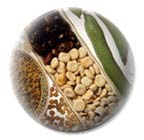- Home
- Introductions

|
Vegetable Seed Production: BeetYou are here: Seed Production: Chenopodiaceae: Beet
Botany Most plants in the Chenopodiaceae family have small single flowers and plants are bisexual or unisexual, sometimes dioecious. In some cases two or more flowers grow together in a dense cluster and form a multiple fruit called a utricle that contains multiple embryos. With beets, the calyx continues to grow after flowering, becomes corky and completely covers the seeds. The utricle is the propagule planted to grow beets and chard. Soil Nutrition Beets are only slightly tolerant of acid soils and grow best at pH 6.0-6.8. Beets need high levels of most trace elements in the soil to grow and develop normally. Beets are sensitive to boron deficiencies which leads to cavity spot (black necrotic lesions on the roots). Beets have a moderate requirement for N-P-K. Beet are tolerant of saline soil conditions and are considered to be a halophyte. Isolation It is generally accepted that pollen of Beta vulgaris is wind-borne
over relatively long distances and sufficient isolation should therefore
be ensured. Most authorities stipulate isolation distances of at least
500 m between cultivars of the same type (e.g. red globe) and at least
1000 m between different types of cultivar (e.g. between red globe and
cylindrical types). Planting Beets are direct seeded 1/2 inch deep in rows 15 to 20 inches apart with a final in-row spacing of 3 inches. Direct-seeded plots are generally thinned if monogerm cultivars are not used. Beets germinate at soil temperatures above 40 degrees F but optimum germination occurs at 85 degrees F. Irrigation Beets have a shallow root system so they must receive a consistent supply of water to keep the roots from becoming woody. On mineral soils, overhead irrigation is used. The requirement of one inch per week applies. Roguing The roguing of plants for beetroot seed production is considerably more
thorough when the root to seed system is used. The seed to seed system
does not allow the mature root characters to be observed. Root to seed
Seed Harvest The harvesting of beet seed commences when the ‘fruits’ at the bases
of inflorescent side shoots mature. By this stage the fruits have turned
from green to brown. An additional check is to cut transversely a sample
of ripe fruits. Unripe fruits are milky when cut and ripe fruits are mealy.
Seeds ripen successively from the bases of the side shoots to the terminal
point. Care is needed to determine the optimum time for cutting because
the immature seeds shrivel if cut too early, and if cut too late seeds
are lost as a result of shattering. Cleaning After drying, the material is threshed
by a stationary thresher or a combine. The dry straw of beetroot seed
is extremely brittle, and it is therefore important to use a relatively
low cylinder speed and air blast. Concave openings must be wide in order
to avoid producing too many small pieces of straw as it is difficult to
separate these off afterwards. There is relatively little chaff from beetroot
material. Seed Yield A satisfactory yield of beetroot seed in most areas of the world is approximately 1000 kg/ha (892 pounds per acre), although up to twice this amount is achieved in the USA. Seed Identification:
|
||||||||||||||||||||||